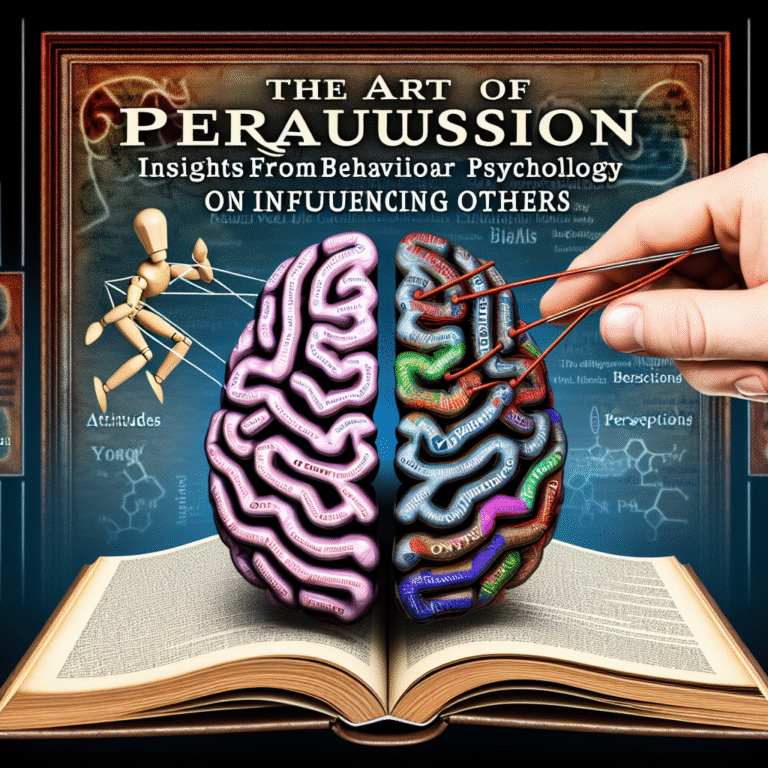
Nudging Towards Success: Proven Behavioral Psychology Techniques to Improve Decision-Making in Organizations
Introduction
In today’s fast-paced and complex business landscape, leaders face a daunting array of choices that can significantly impact their organization’s success. Yet, within this sea of options, decision-making often reflects inherent biases and irrational behaviors. This is where the concept of "nudging" comes into play—a subtle yet powerful approach rooted in behavioral psychology that can effectively steer individuals towards better decisions. By understanding how our minds work and applying strategic nudging techniques, organizations can enhance decision-making processes and ultimately achieve greater success.
This article delves deep into Nudging Towards Success: Behavioral Psychology Techniques to Improve Decision-Making in Organizations, demonstrating how these methods can reshape organizational culture, boost employee engagement, and enhance overall productivity.
Understanding Nudging: The Psychology Behind Decision-Making
What is Nudging?
At its core, nudging refers to the practice of subtly guiding choices without limiting options or altering financial incentives. A nudge employs insights from behavioral psychology to present options in a way that encourages desirable behaviors. For example, placing healthier food options at eye level in a cafeteria can encourage better dietary choices among employees.
The Science of Choice
Decisions are rarely made in a vacuum. Our brains constantly process information, often relying on heuristics—mental shortcuts that simplify decision-making. While these shortcuts can save time, they can also lead to cognitive biases. There are various types of biases, such as confirmation bias, anchoring, and loss aversion, which can cloud judgment. Understanding how these biases operate allows organizations to design nudges effectively.
Real-World Application: The Health Sector
Consider the case of a hospital that implemented nudging techniques to reduce surgical site infections. By changing the default option for surgical teams to use checklists, adherence rates increased dramatically. This nudge not only improved patient outcomes but also demonstrated that nudging can have far-reaching consequences when applied thoughtfully.
The Importance of Behavioral Psychology in Decision-Making
Shaping Organizational Culture
By utilizing behavioral psychology insights, organizations can foster a culture of informed decision-making. This requires the establishment of an environment where employees are aware of their biases and encouraged to reflect on their choices.
Enhancing Employee Engagement
When employees feel empowered to make decisions, they become more engaged. By implementing nudging strategies, organizations can create an environment that fosters curiosity and exploration. For example, when employees are nudged to contribute ideas during brainstorming sessions, it results in a more inclusive atmosphere and enhances overall creativity.
Case Study: Google’s Innovative Work Culture
Google’s use of behavioral nudges has revolutionized how employees interact and innovate. The company encourages collaborative decision-making through tools like "empowerment teams" that embody the nudge philosophy. By promoting group discussions and feedback, Google fosters a creative environment, ultimately driving remarkable decision-making outcomes.
Key Behavioral Psychology Techniques for Effective Nudging
1. Simplification
One of the most effective nudges is simplifying choices. When faced with an overwhelming number of options, individuals often experience choice paralysis. By streamlining available choices, organizations can facilitate easier decision-making and increase satisfaction.
| Complexity Level | Number of Choices | Effectiveness (%) |
|---|---|---|
| High | 20 | 23% |
| Moderate | 10 | 50% |
| Low | 3 | 75% |
2. Framing
The way information is presented can significantly influence decision-making. Positive framing (highlighting benefits) tends to persuade individuals more than negative framing (emphasizing losses). Using a growth mindset in communications can transform responses.
3. Default Options
Default options represent a powerful form of nudging. When organizations set beneficial defaults, they can lead employees to make healthier or more productive choices without mandating compliance.
Example: Automatic Enrollment in Retirement Plans
Studies show that automatic enrollment in retirement savings plans boosts participation from 40% to 90%. By setting this as the default option, organizations successfully nudge employees towards future financial security.
4. Social Proof
Humans are inherently social creatures, making social proof a highly effective nudge. Showing employees that their peers are engaging in desired behaviors can encourage them to follow suit.
5. Commitment Devices
Encouraging employees to publicly commit to specific goals can lead to higher adherence rates. When employees express their intentions in front of others, they are more likely to follow through.
Case Studies: Successful Implementation of Nudges
Case Study 1: The BBC’s Commitment to Healthier Eating
The BBC undertook a project to promote healthier eating habits among employees by leveraging nudging techniques. By providing healthy food choices, implementing visual cues around healthy options, and communicating the benefits of nutritious choices, the organization achieved a 25% increase in the consumption of healthy meals within a month. This initiative not only improved employee well-being but also fostered a culture of health awareness.
Analysis: This case emphasizes the importance of environment and communication in nudging. By shaping workplace culture through thoughtful choices, organizations encourage better decisions.
Case Study 2: Carnegie Mellon University’s Energy-Nudging Project
Carnegie Mellon University implemented a project aimed at reducing campus energy consumption. By utilizing real-time feedback on energy usage and providing comparisons against peers, the university experienced a 15% reduction in energy consumption across participating buildings.
Analysis: This example showcases the effectiveness of immediate feedback as a nudge. By making energy consumption transparent and socially relevant, the university motivated individuals to change their behavior.
Implementing Nudging Strategies in Your Organization
1. Identify Key Decision Points
To effectively implement nudging, organizations must first identify friction points in their decision-making processes. This could involve analyzing employee feedback and observing decision pathways.
2. Design Thoughtful Nudges
Once key decision points are identified, leaders can design nudges that align with organizational goals. Whether it’s reducing turnover, improving productivity, or promoting health, each nudge should be tailored to address these specific needs.
3. Test and Iterate
Nudges require testing and fine-tuning to maximize effectiveness. Implementing pilot programs and gathering data can provide insights into what works and what doesn’t, allowing for continued refinement.
4. Educate Employees
Empowering employees with knowledge about decision-making biases can lead to a cultural shift. Workshops, training, and informal discussions can promote awareness and acceptance of nudging as a valuable tool.
Conclusion
Incorporating nudging strategies within organizations is not merely a trend; it’s an essential approach backed by behavioral psychology that can significantly enhance decision-making processes. By embracing Nudging Towards Success: Behavioral Psychology Techniques to Improve Decision-Making in Organizations, leaders can transform the way employees engage with choices, streamlining operations and fostering a culture of informed decision-making.
As you look to the future, consider the impact you can make by nurturing a decision-friendly environment. A proactive approach to nudging can catalyze profound changes, ultimately leading organizations towards unparalleled success and innovation.
FAQs
1. What is the primary goal of nudging in organizations?
The primary goal of nudging in organizations is to subtly guide individuals towards better decision-making without restricting their choices or incentives. This leads to improved outcomes for personal and organizational goals.
2. How can organizations identify decision points where nudging is needed?
Organizations can identify decision points by analyzing areas where employees struggle with choices, gathering employee feedback, and observing decision-making processes to pinpoint friction points.
3. Can nudging techniques be applied in all types of organizations?
Yes, nudging techniques can be tailored to fit various organizational contexts, including corporate, educational, non-profit, and governmental settings. The key is to customize approaches to each unique culture and environment.
4. Are there any ethical considerations when implementing nudges?
Yes, ethical considerations are crucial when implementing nudges, as they should always support the well-being of individuals. Transparency, informed consent, and the avoidance of manipulation are essential to maintain ethical standards.
5. How can organizations measure the success of nudging strategies?
Organizations can measure the success of nudging strategies through data collection and analysis of key performance indicators (KPIs), employee feedback, participation rates, and the impact on decision outcomes over time.
Through thoughtful application of these Nudging Towards Success: Behavioral Psychology Techniques to Improve Decision-Making in Organizations, you can drive meaningful change and create a more conducive work environment where successful decision-making flourishes.














